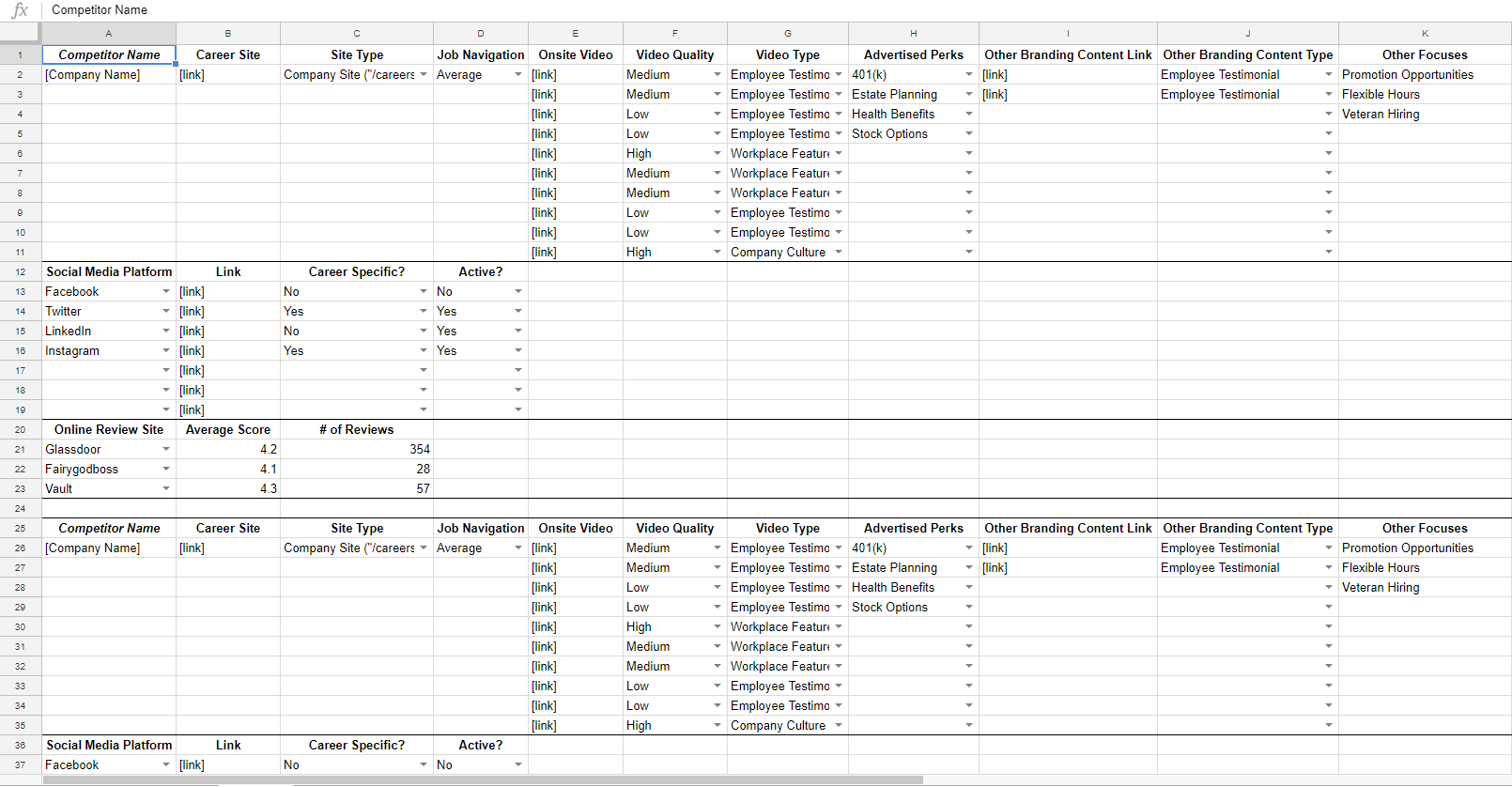5 Steps to Conducting a Competitive Employer Brand Audit

There’s a lot of employer branding advice out there.
While some employer branding principles are applicable in any situation, others are more niche. Some are more expensive and time-consuming than others. It can be difficult to know what advice will give you the most benefit in your organization. How do you identify what to actually implement?
A competitive employer brand audit will help you identify where you should allocate your resources and build a more attractive brand than your direct talent competitors.
What is a Competitive Employer Brand Audit?
In a nutshell, a competitive employer brand audit is a comprehensive examination of how your competitors present themselves to potential applicants.
At a high level, the three primary goals of the audit should be:
- Identify gaps. What areas (social media, etc) or content (video-based content, testimonials, etc) do your competitors focus on that you don’t?
- Identify opportunities. What are your competitors not doing that could set you apart?
- Evaluate messaging. How do your competitors talk to potential applicants?
Step 1: Establish What You Expect to Learn
Without specific expectations you won’t get specific results to take action on. An expectation like “identify what makes a brand that attracts more qualified applicants” – while clearly the optimal result – is too many steps removed from what you have direct control over.
Examples of more specific, practical expectations for the audit (that you can take action on immediately) include:
- Learn how your video-based branding efforts compare to your competitors’. If most of the competition hosts employee testimonials on their career site, and you do not, it may be time to play catch-up.
- Learn where (and how) your competitors are interacting with candidates on social media. If your competitors all have an active, dedicated @[Company Name]Jobs Twitter handle, maybe you should too. On the flip side, maybe none of your competitors offer this resource to candidates; this could be a great opportunity to set your company apart.
- Establish a baseline rating for third-party review sites (Glassdoor, etc). If your employees are leaving phenomenal reviews that set you apart, great! If not, consider investigating the root cause.
- Learn what groups your competition addresses. There could be an overwhelming focus on veteran hiring, diversity, or students. If they have a focus you don’t, maybe they know something you do not.
We’ll look at some other parameters to audit later in this piece. Each expectation should be tied to an action, depending on your company’s performance relative to the competition.
Step 2: Identify Your Competitors
Identifying the right competitors is essential to conducting a useful audit.
Generally speaking, it is not productive to compare your organization’s brand to those of branding giants in the tech and apparel space (unless you are in the tech and apparel space – and even then some caveats apply).
If you track where candidates who turn down your job offers ultimately end up, this is the time to use that data. If not, consider defining “competitor” according to a few different dimensions:
- Local Competitors. These are competing for talent in your immediate vicinity. Depending on your industry, how much this matters will vary.
- Industry Competitors. Generally speaking, people gain industry specialties (manufacturing, tech, retail, etc) that keep them working in that industry. These competitors compete with you for these niche applicants.
- Direct Business Competitors. These are companies your CEO would identify as “competitors.” Are they also competing for candidates? It depends. There may not be much overlap in potential applicant pools if your competition is on the other side of the country.
You should also interview hiring managers to see where their top candidates who rejected job offers headed. While not as scientific as an actual database, this can identify some unexpected competitors.
How many competitors should you audit?
This depends. Ideally you should audit a mix of competitors, according to the dimensions outlined above. It could be that your local competitors are branding in a totally different way than your industry competitors; it’s important to document this difference.
As a rule of thumb, 10-20 competitors is the sweet spot. Any more than that is too time-consuming, and any less probably isn’t representative of the competitive landscape.
Step 3: Identify What You Should Audit
To identify what exactly you should audit, you need to answer the following two questions:
- What influences the way potential applicants see you as an employer?
- What influences the way potential applicants see your competitors?
These are list of employer brand elements you might consider auditing. To be clear, this list is far from inclusive. Use it as a jumping-off point:
- Career Pages. Identify and link to the competitor’s dedicated career page.
- Career Site Type. Identify if the career site a subdomain, a microsite, a third-party site, or on the company’s main site (eg, “/careers”). This might seem superfluous, but site type plays a role in how a company’s career site ranks in Google Search.
- Job Navigation. Rate how easy – or difficult – it is to navigate open roles. The rankings we use in the example below are “Intuitive,” “Average,” and “Difficult.”
- Onsite Video. Collect and categorize all video content for potential candidates.
- Video Quality. Rate video as high, medium, or low quality. This way you can evaluate what sort of budget your competitors are putting into video content.
- Video Type. Categorize each video. Video types include employee testimonials, workplace features, and company overviews.
- Advertised Perks. Identify any perks the competitor advertises.
- Social Media Platform. Identify the social media platforms the competitor is on.
- Social Media Specificity. Identify if the competitor has a specific “careers” social media account on each platform.
- Social Media Activity. Evaluate if the is competitor active.
- Online Review Sites. Identify what online review sites the competitor is featured on.
- Online Review Ratings. Record how the competitor is rated on each review site.
- Online Reviews. Record how many reviews the competitor has on each review site.
- Other Branding Content. Identify any other content (written, virtual reality, etc) the competitor offers that helps build their employer brand.
- Other Focuses. Identify any other notable focuses on the competitor’s career site, social media, or third party review site that cannot be otherwise categorized. These might be a focus on veteran hiring, student recruiting, or how their workplace is accessible to employees with disabilities. If a you notice certain focus occurring frequently, you should consider adding it as its own category to your audit.
Here is an example of what this might look like for each competitor (we’re using Google Sheets here):
To keep all competitors in the same sheet, you can copy and paste the template down so it looks something like this:
If this gets too unwieldy, you should give each type of competitor (local, industry, etc) their own tab.
Step 4: Audit & Review Trends
The audit itself is pretty manual. Most career sites aren’t organized in exactly the same way, so it will probably take some searching to find what you need.
After you’ve audited each competitor according to the criteria you decided on previously, it’s time to review trends.
Generally speaking, the best way to do this is by evaluating the relative frequency of each factor you’ve audited. For example:
- Percent of competitors who have employee testimonials on their career site;
- Percent of competitors who specifically target veterans;
- Percent of competitors who are active on Facebook, etc.
As you do this, you’ll probably notice different trends within each subset of competitors (local, industry, direct business). Note these as well.
Remember the three primary goals for the audit? Map your findings to those goals:
- Identify gaps. For example, if a high percentage of competitors offer a certain type of branding content, are active on a specific social media platform, or target a specific group – and you don’t – this is probably a gap you should fill.
- Identify opportunities. On the flip side, what are your competitors not doing? There could be a reason none of your competitors are putting out a certain type of branding content (eg, they’ve tried and didn’t see any results), or maybe they just haven’t thought to (in which case this is an opportunity).
- Evaluate messaging. This one has to do with how you talk to potential applicants at a high level. For example, if your competitors are putting a heavy focus on flexible hours, but your primary focus is promotion opportunities, you might be missing a crucial applicant pool.
Step 5: Take Action (and Sell Initiatives Internally)
After identifying gaps and opportunities, you need to prioritize. Since every organization’s situation is so different, there isn’t much generally applicable advice aside from “work smart.” This boils down to a cost-benefit analysis, taking into account:
- What resources you have available.
- How large each gap is (eg, what percentage of competitors offer a specific thing that you don’t).
- The impact closing each gap will have in relation to the resources required to close it.
- The impact of pursuing each opportunity in relation to the resources required to do so.
Fortunately, once you decide on a plan of action, you know you’re not taking a “see what sticks” approach.
A completed competitive employer brand audit helps validate any new initiatives you decide to pursue. It’s one thing to tell a skeptical stakeholder that you’re doing something because “everybody else is doing it.” It’s another thing entirely to say “we’re doing this because 80% of our direct talent competitors are, and we are behind.”
Remember that a competitive employer brand audit is backward-looking. It won’t give you much insight into the most impactful branding activities of tomorrow, but it will help you set a baseline for today and present a compelling case to skeptics.
Want to audit your competitor’s employer branding initiatives and create a more attractive brand?





